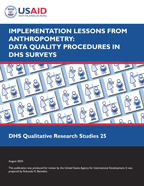There is no printed copy available to order.
Abstract:
Anthropometric data collection at The
Demographic and Health Surveys (DHS) Program
includes bothstandardization exercises and
child remeasurement, but the settings in
which surveys are implemented can
affect the quality of anthropometric data.
This qualitative study was conducted to
understand the elements
that foster or hinder the success of current
procedures. Semi-structured interviews with
(1) 12 staff and
consultants from The DHS Program and (2) 17
implementing agency staff from the 2023
Jordan Population
and Family Health Survey were conducted.
Three observations of child remeasurement
were also conducted
in Jordan.
Study results suggest that recruiting
children works best if implementing agencies
know how many children
will be required and provide sufficient
stipends to caretakers. Working with
community organizers, health
centers, or the Ministry of Health can help
with recruitment. Other factors that may
affect the success of
training and standardization include
location, length of training, age of
equipment, size of venue, number
of trainers, whether trainees practice on
both easy- and difficult-to-measure children,
and how well
interviewers and technicians communicate
during fieldwork practice. Informants
suggested alternative
approaches to standardization (such as fewer
children in the room at the same time) and
ways to minimize
children’s discomfort (such as singing rhymes
and avoiding measurements during nap time).
Although most
trainees pass standardization exercises,
incorrect reading of measurements, lack of
coordination between
measurers and assistants, and children’s
hairstyles were given as possible reasons for
failure.
Many informants thought that remeasurement
improves data quality and overall, informants
agreed that the
computer-assisted personal interviewing
program for remeasurement works well.
However, responses were
mixed regarding the fieldwork component of
remeasurement. Reported challenges included
difficulty
returning to households, pressure to complete
remeasurements quickly, and rare gaming
practices (such as
copying original measurements instead of
remeasuring). Results also showed a need for
strengthening the
use of field check tables to monitor
remeasurement data quality.
Many of the study recommendations are already
being implemented or will be addressed as
part of The
DHS Program’s commitment to collecting
quality anthropometric data in surveys.
 Implementation Lessons from Anthropometry: Data Quality Procedures in DHS Surveys (PDF, 1145K)
Implementation Lessons from Anthropometry: Data Quality Procedures in DHS Surveys (PDF, 1145K)
